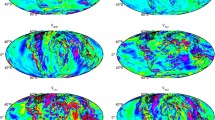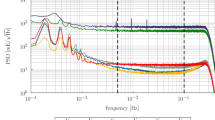Abstract
In 2009 the European Space Agency satellite mission GOCE (Gravity Field and Steady-State Ocean Circulation Explorer) was launched. Its objectives are the precise and detailed determination of the Earth’s gravity field and geoid. Its core instrument, a three axis gravitational gradiometer, measures the gravity gradient components V xx , V yy , V zz and V xz (second-order derivatives of the gravity potential V) with high precision and V xy , V yz with low precision, all in the instrument reference frame. The long wavelength gravity field is recovered from the orbit, measured by GPS (Global Positioning System). Characteristic elements of the mission are precise star tracking, a Sun-synchronous and very low (260 km) orbit, angular control by magnetic torquing and an extremely stiff and thermally stable instrument environment. GOCE is complementary to GRACE (Gravity Recovery and Climate Experiment), another satellite gravity mission, launched in 2002. While GRACE is designed to measure temporal gravity variations, albeit with limited spatial resolution, GOCE is aiming at maximum spatial resolution, at the expense of accuracy at large spatial scales. Thus, GOCE will not provide temporal variations but is tailored to the recovery of the fine scales of the stationary field. GRACE is very successful in delivering time series of large-scale mass changes of the Antarctic ice sheet, among other things. Currently, emphasis of respective GRACE analyses is on regional refinement and on changes of temporal trends. One of the challenges is the separation of ice mass changes from glacial isostatic adjustment. Already from a few months of GOCE data, detailed gravity gradients can be recovered. They are presented here for the area of Antarctica. As one application, GOCE gravity gradients are an important addition to the sparse gravity data of Antarctica. They will help studies of the crustal and lithospheric field. A second area of application is ocean circulation. The geoid surface from the gravity field model GOCO01S allows us now to generate rather detailed maps of the mean dynamic ocean topography and of geostrophic flow velocities in the region of the Antarctic Circumpolar Current.






Similar content being viewed by others
References
Andersen OB et al (2008) The DTU10 global Mean sea surface and Bathymetry. Presented EGU-2008, Vienna, Austria, April, 2008
Albertella A, Rummel R (2009) On the spectral consistency of the altimetric ocean and geoid surface, a one-dimensional example. J Geod 83:805–815. doi:10.1007/s00190-008-02999-5
Allison I, Alley R, Fricker H, Thomas R, Warner R (2009) Ice sheet mass balance and sea level. Antarct Sci 21(5):413–426. doi:10.1017/S0954102009990137
Armano M et al (2009) LISA Pathfinder: the experiment and the route to LISA. Class Quantum Grav 26:094001. doi:10.1088/0264-9381/26/9/094001
Balmino G, Perosanz F, Rummel R, Sneeuw N, Sünkel H (1999) CHAMP, GRACE and GOCE: mission concepts and simulations. Boll Geof Teor Appl 40(3–4):309–319
Balmino G, Perosanz F, Rummel R, Sneeuw N, Sünkel H, Woodworth PL (1998) European views on dedicated gravity field missions: GRACE and GOCE. European Space Agency, ESD-MAG-REP-COW-01
Bevis M, Kendrick E, Smalley Jr R, Dalziel I, Caccamise D, Sasgen I, Helsen M, Taylor FW, Zhou H, Brown A, Raleigh D, Willis M, Wilson T, Konfal S (2009) Geodetic measurements of vertical crustal velocity in West Antarctica and the implications for ice mass balance. Geochem Geophys Geosystems 10(10):Q10005. doi:10.1029/2009GC002642
Bindschadler R (2006) The environment and evolution of the West Antarctic ice sheet: setting the stage. Phil Trans R Soc A 364(1844):1583–1605. doi:10.1098/rsta.2006.1790
Böning C, Timmermann R, Danilov S, Schröter J (2010) Antarctic circumpolar current transport variability in GRACE gravity solutions and numerical ocean model simulations. In: Flechtner FM, Gruber T, Güntner A, Mandea M, Rothacher M, Schöne T, Wickert T (eds) System earth via geodetic-geophysical space techniques. Springer, Berlin, pp 187–199. doi:10.1007/978-3-642-10228-8_15
Bosch W, Savcenko R (2007) Satellite altimetry: multi-mission cross calibration. In: Tregoning P, Ch Rizos (eds) Dynamic planet 2005. IAG symposia 130:51–56. Springer, Berlin
Chao BF (2003) Geodesy is not just for static measurements anymore. Eos Trans AGU 84(16). doi:10.1029/2003EO160001
Chen JL, Wilson CR, Blankenship D, Tapley BD (2009) Accelerated Antarctic ice loss from satellite gravity measurements. Nat Geosci 2:859–864. doi:10.1038/ngeo694
Dettmering D, Bosch W (2010a) Global calibration of Jason-2 by multi-mission crossover analysis. Marine Geod 33(S1):150–161. doi:10.1080/01490419.2010.487779
Dettmering D, Bosch W (2010b) Envisat radar altimeter calibration by multi-mission crossover analysis. In: Proceedings of ESA living planet symposium, SP-686, ESA ESTEC, Noordwijk, The Netherlands, ISBN 978-92-9221-250-6
Drinkwater M, Haagmans R, Muzi D, Popescu A, Floberghagen R, Kern M, Fehringer M (2007) The GOCE Gravity Mission: ESA’s first core earth explorer. In: Proceedings of 3rd International GOCE User Workshop, ESA SP-627, Frascati
Förste C, Flechtner F, Schmidt R, Stubenvoll R, Rothacher M, Kusche J, Neumayer H, Biancale R, Lemoine J-M, Barthelmes F, Bruinsma S, König R, Meyer U (2008a) EIGEN-GL05C–A new global combined high-resolution GRACE-based gravity field model of the GFZ-GRGS cooperation. Geophys Res Abstr 10:EGU2008-A-03426
Förste C, Schmidt R, Stubenvoll R, Flechtner F, Meyer U, König R, Neumayer H, Biancale R, Lemoine J-M, Bruinsma S, Loyer S, Barthelmes F, Esselborn S (2008b) The GeoForschungsZentrum Potsdam/Groupe de Recherche de Gèodésie Spatiale satellite-only and combined gravity field models: EIGEN-GL04S1 and EIGEN-GL04C. J Geod 82:331–346. doi:10.1007/s00190-007-0183-8
Han S-C, Shum CK, Ditmar P, Visser P, van Beelen C, Schrama EJO (2006) Aliasing effect of high-frequency mass variations on GOCE recovery of the Earth’s gravity field. J Geodyn 41:69–76
Horwath M, Dietrich R (2009) Signal and error in mass change inferences from GRACE: the case of Antarctica. Geophys J Int 177(3):849–864. doi:10.1111/j.1365-246X.2009.04139.x
Horwath M, Legrésy B, Rémy F, Blarel F, Lemoine J-M (2010) Consistent patterns of Antarctic ice sheet interannual variations from ENVISAT radar altimetry and GRACE satellite gravimetry. Geophys Res Abstr 12:EGU2010-4972
Ivins ER, James TJ (2005) Antarctic glacial isostatic adjustment: a new assessment. Antarct Sci 17(4):541–553
Jäggi A (2007) Pseudo stochastic orbit modelling of low earth satellites using the global positioning system. Geodätisch-geophysikalische Arbeiten in der Schweiz, 73, Schweizerische Geodätische Kommission, ISBN 978–3–908440–17–8
Jarecki F, Müller J, Petrovic S, Schwintzer P (2005) Temporal gravity variations in GOCE gradiometric data. In: Jekeli C, Bastos C, Fernandes J (eds) Gravity, geoid and space missions: GGSM 2004. IAG International Symposium Porto, Portugal, August 30–September 3, 2004. Springer, Berlin, pp 333–338
Joughin I, Tulaczyk S (2002) Positive mass balance of the Ross ice streams, West Antarctica. Science 295:476–480
Kaula WA (1966) Theory of satellite geodesy. Blaisdell Publishing Group, Waltham
King MA, Altamimi Z, Boehm J, Bos M, Dach R, Elosegui P, Fund F, Hernandez-Pajares M, Lavallee D, Cerveira PJM, Penna N, Riva REM, Steigenberger P, van Dam T, Vittuari L, Williams S, Willis P (2010) Improved constraints on models of glacial isostatic adjustment: a review of the contribution of ground-based geodetic observations. Surv Geophys 31:465507. doi:10.1007/s10712-010-9100-4
Moore P, King MA (2010) Satellite gravity gradiometry: secular gravity field change over polar Regions. J Geodyn 49:247–253. doi:10.1016/j.jog.2010.01.007
Office of Science and Technology Policy (2010) Achieving and sustaining earth observations: a preliminary plan based on a strategic assessment by the US group on earth observations. Washington DC. http://www.whitehouse.gov/sites/default/files/microsites/ostp/ostp-usgeo-report-earth-obs.pdf. Accessed 5 Jan 2011
Pail R, Wermuth M (2003) GOCE SGG and SST quick-look gravity field analysis. Adv Geosci 1:5–9
Pail R, Goiginger H, Schuh W-D, Höck E, Brockmann JM, Fecher T, Gruber T, Mayer-Gürr T, Kusche J, Jäggi A, Rieser D (2010) Combined satellite gravity field model GOCO01S derived from GOCE and GRACE. Geophys Res Lett 37:L20314. doi:10.1029/2010GL044906
Peltier WR (2004) Global glacial isostasy and the surface of the ice-age earth: the ICE-5G (VM2) Model and GRACE. Ann Rev Earth Planet Sci 32(1):111–149. doi:10.1146/annurev.earth.32.082503.144359; (AN 13161612)
Plag H-P, Pearlman M (eds) (2009) Global geodetic observing system–meeting the requirements of a global society on a changing planet in 2020. Springer, Berlin
Pritchard HD, Arthern RJ, Vaughan DG, Edwards LA (2009) Extensive dynamic thinning on the margins of the Greenland and Antarctic ice sheets. Nature 461:971–975. doi:10.1038/nature08471
Ramillien G, Lombard A, Cazenave A, Ivins ER, Llubes M, Rémy F, Biancale R (2006) Interannual variations of the mass balance of the Antarctica and Greenland ice sheets from GRACE. Glob Planet Change 53:198–208
Rietbroek R, LeGrand P, Wouters B, Lemoine J-M, Ramillien G, Hughes CW (2006) Comparison of in situ bottom pressure data with GRACE gravimetry in the Crozet-Kerguelen region. Geophys Res Lett 33:L21601. doi:10.1029/2006GL027452
Rignot E, Bamber J, van den Broeke MR, Davis C, Li Y, van de Berg WJ, van Meijgaard E (2008) Recent Antarctic ice mass loss from radar interferometry and regional climate modelling. Nat Geosci 1(13Jan 2008):106–110. doi:10.1038/ngeo102
Riva REM, Gunter BC, Urban TJ, Vermeersen BLA, Lindenbergh RC, Helsen MM, Bamber JL, van de Wal RSW, van den Broeke MR, Schutz BE (2009) Glacial Isostatic Adjustment over Antarctica from combined ICESat and GRACE satellite data. Earth Planet Sci Lett 288:516–523. doi:10.1016/j.epsl.2009.10.013
Rülke A, Dietrich R, Fritsche M, Rothacher M, Steigenberger P (2008) Realization of the Terrestrial Reference System by a reprocessed global GPS network. J Geophys Res 113:B08403. doi:10.1029/2007JB005231
Rummel R (2003) How to climb the gravity wall. In: Beutler G, Rummel R, Drinkwater MR, von Steiger R (eds) Earth gravity field from space–from sensors to earth sciences, Space Science Reviews, 108:1–14
Rummel R (2010) GOCE: gravitational gradiometry in a satellite, handbook of geo-mathematics, ch. 22. Springer, Heidelberg, Berlin
Rummel R, Gruber T (2010) Gravity and steady-state ocean circulation explorer GOCE. In: Flechtner F, Gruber T, Güntner A, Mandea M, Rothacher M, Schöne T, Wickert J (eds) System earth via geodetic–geophysical space techniques. Springer, Heidelberg, Berlin, pp 203–212
Sabaka TJ, Rowlands DD, Luthcke SB, Boy JP (2010) Improving global mass flux solutions from Gravity Recovery and Climate Experiment (GRACE) through forward modeling and continuous time correlation. J Geophys Res 115(B11403). doi:10.1029/2010JB007533
Sasgen I, Dobslaw H, Martinec Z, Thomas M (2010a) Satellite gravimetry observation of Antarctic snow accumulation related to ENSO. Earth Plan Sci Lett. doi:10.1016/j.epsl.2010.09.015
Sasgen I, Martinec Z, Bamber J (2010b) Combined GRACE and InSAR estimate of West Antarctic ice-mass loss. J Geophys Res. doi:10.1029/2009JF001543
Schaeffer P, Ollivier A, Faugere Y, Bronner E, Picot N (2010) The new CNES CLS 2010 Mean Sea Surface. Oral presentation at OSTST 2010 meeting: http://www.aviso.oceanobs.com/fileadmin/documents/OSTST/2010/oral/Schaeffer.pdf
Scheinert M, Müller J, Dietrich R, Damaske D, Damm V (2007) Regional geoid determination in Antarctica utilizing airborne gravity and topography data. J Geod. doi:10.1007/s00190-007-0189-2
Schmidt R, Flechtner F, Meyer U, Neumayer K-H, Dahle C, König R, Kusche J (2008) Hydrological signals observed by the GRACE satellites. Surv Geophys 29:319–334. doi:10.1007/s10712-008-9033-3
Stewart, RH (2003) Introduction to physical oceanography. Department of Oceanography, Texas A&M University
Sumner TJ (2009) The STEP and GAUGE missions. Space Sci Rev 148(1–4):475–487. doi:10.1007/s11214-009-9558-x
Švehla D, Rothacher M (2004) Kinematic precise orbit determination for gravity field determination. In: Sansò F (ed) The proceedings of the international association of geodesy: a window on the future of geodesy. Springer, Berlin, pp 181–188
Swenson S, Wahr J (2002) Methods for inferring regional surface-mass anomalies from Gravity Recovery and Climate Experiment (GRACE) measurements of time-variable gravity. J Geophys Res 107(B9):2193. doi:10.1029/2001B000576
Tapley BD, Bettadpur S, Ries JC, Thompson PF, Watkins M (2004) GRACE measurements of mass variability in the earth system. Science 305(5683):503–505. doi:10.1126/science.1099192
Thomas RH (2001) Program for Arctic Regional Climate Assessment (PARCA): goals, key findings, and future directions. J Geophys Res 106(D24):33691–33705
Touboul P (2009) The microscope mission and its uncertainty analysis. Space Sci Rev 148(1–4):455–474. doi:10.1007/s11214-009-9565-y
Velicogna I (2009) Increasing rates of ice mass loss from the Greenland and Antarctic ice sheets revealed by GRACE. Geophys Res Lett 36:L19503. doi:10.1029/2009GL040222
Velicogna I, Wahr J (2006) Measurements of time-variable gravity show mass loss in Antarctica. Science 311(5768):1754–1756
Vitale S (2009) Space-time metrology for the LISA gravitational wave observatory, and its demonstration on LISA pathfinder. Space Sci Rev 148(1–4):441–454. doi:10.1007/s11214-009-9521-x
von Frese RRB, Tan L, Kim JW, Bentley CR (1999) Antarctic crustal modeling from the spectral correlation of free-air gravity anomalies with the terrain. J Geophys Res 104(B11):25,275–25,296. doi:10.1029/1999JB900232
Wahr J, Molenaar M, Bryan F (1998) Time variablity of the Earth’s gravity field: hydrological and oceanic effects and their possible detection using GRACE. J Geophys Res 103(B12):30205–30229
Wahr J, Wingham D, Bentley C (2000) A method of combining ICESat and GRACE satellite data to constrain Antarctic mass balance. J Geophys Res 105(B7):16,279–16,294
Wingham DJ, Wallis DW, Shepherd A (2009) Spatial and temporal evolution of Pine Island Glacier thinning 1995–2006. Geophys Res Lett 36:L17501. doi:10.1029/2009GL039126
Wu X, Heflin MB, Schotman H, Vermeersen BLA, Dong D, Gross RS, Ivins ER, Moore AW, Owen SE (2010) Simultaneous estimation of global present-day water transport and glacial isostatic adjustment. Nat Geosci 3:642–646. doi:10.1038/NGEO938
Zlotnicki V, Wahr J, Fukumori E, Zong YT (2007) Antarctic circumpolar current transport variability during 2003–05 from GRACE. J Phys Oceanogr 37:230–244. doi:10.1175/JPO3009.1
Zwally HJ, Schutz B et al (2002) ICESat’s laser measurements of polar ice, atmosphere, ocean, and land. J Geodyn 34(3–4):405–445
Acknowledgments
The work of the first and third author is supported by the Institute for Advanced Study of Technische Universität München. Additional support of the work of the third author comes from Institute of Geodesy and Geophysics, Chinese Academy of Sciences. The work of the second author was supported by a research fellowship of the Deutsche Forschungsgemeinschaft (DFG). Roman Savcenko (German Geodetic Research Institute, DGFI) together with the fifth author provided the altimetric mean surface from the multi-mission analysis.
Author information
Authors and Affiliations
Corresponding author
Rights and permissions
About this article
Cite this article
Rummel, R., Horwath, M., Yi, W. et al. GOCE, Satellite Gravimetry and Antarctic Mass Transports. Surv Geophys 32, 643–657 (2011). https://doi.org/10.1007/s10712-011-9115-5
Received:
Accepted:
Published:
Issue Date:
DOI: https://doi.org/10.1007/s10712-011-9115-5




